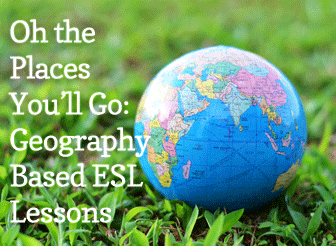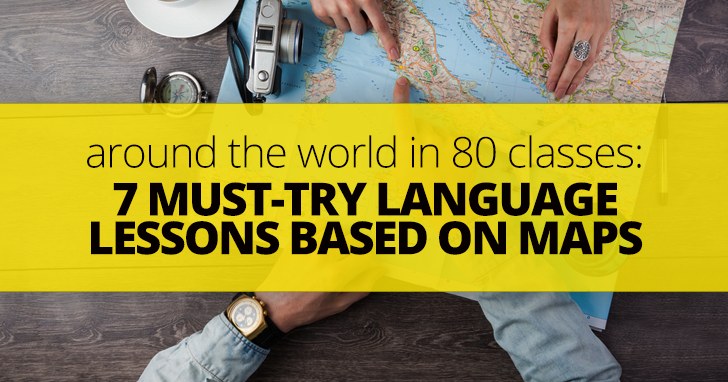Oh the Places You’ll Go: Geography Based ESL Lessons


Have you discovered what a great jumping off point maps are for interesting and engaging ESL lessons? You can use them to get students talking, evaluate their listening skills, and have them write about places all over the world. If you want to use maps in your classroom, here are seven ideas for taking your students around the world without leaving class.
For this activity, you can use a map of a real location or draw your own simple map of a town. On your map, you’ll want to include some common locations such as the library, fire and police departments, the grocery store, and perhaps a few houses. Feel free to design your map to include whatever places fit in with the unit you are teaching your students. Then make a copy of the map for each of your students. Have them start at a particular location and give them verbal directions to another place without telling them the location to test their listening comprehension. (Or put your directions in writing to test reading comprehension.) As you give directions, your students should run their fingers along the map as if they were cars driving on the streets. When you have completed your directions, ask students where they ended up on the map to see how well the followed your directions.
If you could go anywhere in the world, where would you go? It’s a great question to ask your ESL students. Some would travel to the wonders of the world. Others may prefer the comforts of home. Wherever your students want to go, have them show if off by marking the spot on a world map displayed in your classroom. After that, have them print a map of their vacation destination and locate the different sites to see in the area. Then give each person a few minutes in front of the class to show their site seeing map and share a little bit about each of the places they would like to visit. Finally, have each person plan a one week or one day itinerary for seeing all the great places they marked on their city’s map.
If you teach a reading class, have you taken the time to teach the different types of reading? Reading for detail, skimming, and scanning are all different approaches to taking in the words on the page, and each is useful in certain circumstances. Maps are a great way to give students practice at scanning – reading for specific information. Since the writing on maps isn’t in pros, students will have to move their eyes over the entire page to find the information they seek. You might have your students read a weather map, a map of roads and highways, or a political map to look for certain information or answer comprehension questions based on the information they will find there.
Why should the cartographers have all the fun? Let your students make their own maps of unique and imaginative places known only to them. Brainstorm a list of places that most towns have, and then let each student draw a map of his own perfect place. As students draw, you might want to review the different symbols that are used on maps for roads, highways, areas of water, etc. Have each person present their map to the rest of the class, taking time to explain what they included in their perfect place and why.
And while your students are exercising their creativity making their own maps, why not have them make a map of a fictional location they have read about or have seen in a movie? Choose a novel, short story, movie, or television show according to the skill level of your students. Students will use their reading comprehension and listening comprehension skills to gather the information they need to complete the project. As they read or watch, students should take note of the different locations present in the fictional piece as well as their relation to each other. Let students compare their notes to make sure everyone has all of the information they need about the places in that fictional world. Then let students make their own maps of that location. Take some wall space in your classroom to display all of the maps so students can see how they imagined that fictional place compared to their classmates.
When we talk about our own lives or ask other people about theirs, much of the information is relayed chronologically. I did that when I was five. I did this when I was twenty. And so on. But what if instead of relaying the important events in our lives according to when they happened, we relayed them according to WHERE they happened. I learned to ride my bike in this place. I received my college diploma here. You can help your students share their lives this way in this simple activity. Have students brainstorm some of the most important events in their lives, from their birth to their wedding days or whatever they think are the most interesting or important events in their lives. Have students list these events on a sheet of paper divvied in to three columns. In the second column, have students list when that event happened. In the third column, have them list where each event happened. Then, depending on how spaced out the events are, have students print a blank map (world map, country map, city map, etc.) and label the important places in which their life events happened. They can mark each place with a dot and then draw a line from the dot to a blank space in the margins of the map. There they should write a sentence or two about each event. Display your students’ maps around the classroom and let them see where the important things in their classmates’ lives happened.
How well do your students know some of the world’s most famous landmarks? Can they find them on a map? Print out a list of famous landmarks throughout the world for each group of three or four students. Make sure you have some very well-known landmarks as well as some more obscure ones. Have students cut apart the places on their list and then place the slips on a world map according to where those landmarks are. If you like, put each map on a piece of cardboard and have students pin each landmark to its location on the map. Some landmarks will be easy to place (such as the Eifel tower), but other landmarks will be less obvious (where exactly is the Grand Canyon). Have students work together and discuss with their group where each landmark should be placed. When all the groups are finished, reveal to them the actual locations of the landmarks and see how many they got right.
Encourage your students to read, write, listen, and speak with these activities, and oh the places they will go!